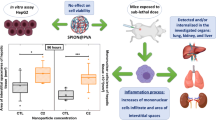Abstract
The biocompatibility and biodistribution of magnetic nanoparticles (MNPs) in vivo are essential to ensure their safely clinical application. We have studied these aspects with our 3-aminopropyltriethoxysilane-coated magnetic nanoparticles (APTS-MNPs) formulation, which can be used as magnetic induction hyperthermia media. Changes in tissue iron levels were analyzed after intraperitoneal injection of APTS-MNPs to ICR mice. Liver and kidney functions were tested. Heart, liver, spleen, lung, kidney, testis, and brain were sectioned for pathological analysis. Biodistribution of iron in various body tissues changed with time but greater fraction of the injected iron localized in the liver and spleen than in other tissues. Serum showed an increase in AST and LDH following APTS-MNPs injection. Histological analyses of selected tissues showed no obvious abnormal changes. In conclusion, APTS-MNPs did not cause continuing changes in the liver and kidney function and thus can be safely used for in vivo application.






Similar content being viewed by others
References
Shubayev VI, Pisanic TR, Jin S (2009) Magnetic nanoparticles for theragnostics. Adv Drug Deliv Rev 61:467–477
Ahmadi E, Dehghannejad N, Hashemikia S et al (2013) Synthesis and surface modification of mesoporous silica nanoparticles and its application as carriers for sustained drug delivery. Drug Deliv. doi:10.3109/10717544.2013.838715
Yanes RE, Tarn D, Hwang AA et al (2013) Involvement of lysosomal exocytosis in the excretion of mesoporous silica nanoparticles and enhancement of the drug delivery effect by exocytosis inhibition. Small 9:697–704
Lee GY, Qian WP, Wang L et al (2013) Theranostic nanoparticles with controlled release of gemcitabine for targeted therapy and MRI of pancreatic cancer. ACS Nano 7:2078–2089
Shibu ES, Ono K, Sugino S et al (2013) Photouncaging nanoparticles for MRI and fluorescence imaging in vitro and in vivo. ACS Nano 7:9851–9859
Jin Y, Jia C, Huang SW et al (2010) Multifunctional nanoparticles as coupled contrast agents. Nat Commun 1:41
Tian H, Chen J, Chen X (2013) Nanoparticles for gene delivery. Small 9:2034–2044
Lee CH, Kim EY, Jeon K et al (2008) Simple, efficient, and reproducible gene transfection of mouse embryonic stem cells by magnetofection. Stem Cells Dev 17:133–141
Plank C, Zelphati O, Mykhaylyk O (2011) Magnetically enhanced nucleic acid delivery. Ten years of magnetofection-progress and prospects. Adv Drug Deliv Rev 63:1300–1331
Oliveira TR, Stauffer PR, Lee CT et al (2013) Magnetic fluid hyperthermia for bladder cancer: a preclinical dosimetry study. Int J Hyperth 29:835–844
Sadhukha T, Niu L, Wiedmann TS et al (2013) Effective elimination of cancer stem cells by magnetic hyperthermia. Mol Pharm 10:1432–1441
Johannsen M, Thiesen B, Wust P et al (2010) Magnetic nanoparticle hyperthermia for prostate cancer. Int J Hyperth 26:790–795
Attaluri A, Ma R, Qiu Y et al (2011) Nanoparticle distribution and temperature elevations in prostatic tumours in mice during magnetic nanoparticle hyperthermia. Int J Hyperth 27:491–502
Cano ME, Barrera A, Estrada JC et al (2011) An induction heater device for studies of magnetic hyperthermia and specific absorption ratio measurements. Rev Sci Instrum 82:114904
Jordan A, Wust P, Fahling H et al (2009) Inductive heating of ferrimagnetic particles and magnetic fluids: physical evaluation of their potential for hyperthermia. 1993. Int J Hyperth 25:499–511
Thiesen B, Jordan A (2008) Clinical applications of magnetic nanoparticles for hyperthermia. Int J Hyperth 24:467–474
van Landeghem FK, Maier-Hauff K, Jordan A et al (2009) Post-mortem studies in glioblastoma patients treated with thermotherapy using magnetic nanoparticles. Biomaterials 30:52–57
Sanhai WR, Sakamoto JH, Canady R et al (2008) Seven challenges for nanomedicine. Nat Nanotechnol 3:242–244
Sanvicens N, Marco MP (2008) Multifunctional nanoparticles—properties and prospects for their use in human medicine. Trends Biotechnol 26(8):425–433
Jain TK, Reddy MK, Morales MA et al (2008) Biodistribution, clearance, and biocompatibility of iron oxide magnetic nanoparticles in rats. Mol Pharm 5:316–327
Chen Z, Meng H, Xing G et al (2006) Acute toxicological effects of copper nanoparticles in vivo. Toxicol Lett 163:109–120
Li Y, Chen ZW, Gu N (2012) In vitro biological effects of magnetic nanoparticles. Chin Sci Bull 57:3972–3978
Ma YJ, Yan ZB, Xu H et al (2012) The interaction of GSSG modified magnetic nanoparticles with SPC-A1 cells in vitro. Chin Sci Bull 57:3525–3531
Tang GW, Zhao YH, Yuan XY (2013) Preparation of fiber-microsphere scaffolds for loading bioactive substances in gradient amounts. Chin Sci Bull 58:3415–3421
Zhao YL, Nalwa HS (2007) Nanotoxicology. American Scientific Publishers, California
Yamaura M, Camilo RL, Sampaio LC et al (2004) Preparation and characterization of (3-aminopropyl) triethoxysilane-coated magnetite nanoparticles. J Magn Magn Mater 279:210–217
Wang XW, Kan SX, Zhao LY et al (2010) Surface-modification superparamagnetic nanoparticles for highly-efficient intracellular hyperthermia, 4th International Conference on Bioinformatics and Biomedical Engineering, Chengdu
Pumera M (2011) Nanotoxicology: the molecular science point of view. Chem Asian J 6:340–348
Karlsson HL, Cronholm P, Gustafsson J et al (2008) Copper oxide nanoparticles are highly toxic: a comparison between metal oxide nanoparticles and carbon nanotubes. Chem Res Toxicol 21:1726–1732
Acknowledgments
This work was supported by the National Natural Science Foundation of China (81071885). The authors wish to acknowledge the assistance of Professor Tiande Zhao for ongoing helpful discussions and advice on experiments analysis.
Author information
Authors and Affiliations
Corresponding author
Additional information
Xiaowen Wang, Jieying Zhang and Xin Yang have contributed equally to this work.
SPECIAL TOPIC: Nano Materials
About this article
Cite this article
Wang, X., Zhang, J., Yang, X. et al. In vivo assessment of hepatotoxicity, nephrotoxicity and biodistribution using 3-aminopropyltriethoxysilane-coated magnetic nanoparticles (APTS-MNPs) in ICR mice. Chin. Sci. Bull. 59, 1800–1808 (2014). https://doi.org/10.1007/s11434-014-0296-4
Received:
Accepted:
Published:
Issue Date:
DOI: https://doi.org/10.1007/s11434-014-0296-4




